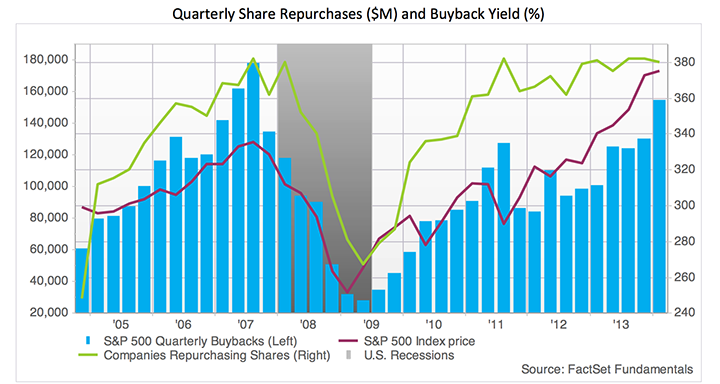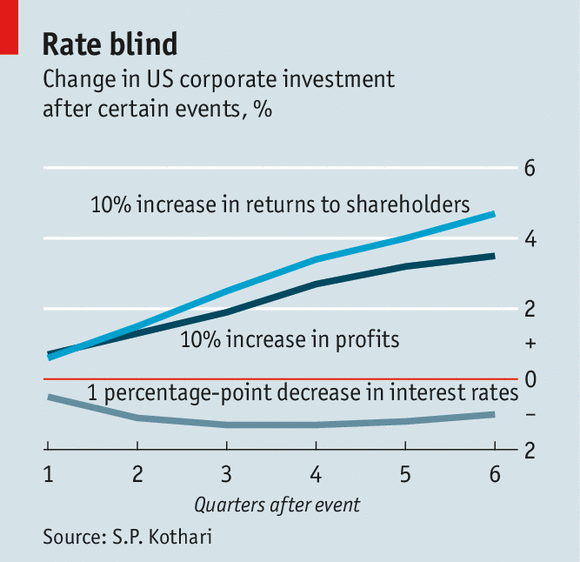This is a quick update on my
recent post on corporate accounting and EPS.
The FT ran a rather bullish
story the other day proclaiming that corporate America is spending again, a sign
of returning confidence they told us.
Their ebullience seems to
have been triggered by the fact that, according to a survey by the Association
for Financial Professionals, corporations’ cash balances have been falling. The
FT assures us that this is an important turning point in our recovery from the
Great Recession. Accordingly, this is a
clear sign that animal spirits are returning to the US economy.
If only it were true. The FT
starts the story this way:
US corporations are starting to run down their cash
for the first time since the recession- a sign of returning confidence- but
they remain reluctant to invest in new equipment.
Let me give you my
translation of this line:
US corporations are confident in their ability to
boost earnings per share so long as they DON’T invest in their businesses by
purchasing new equipment.
The story does note that buybacks
and acquisitions are what the cash is being used for, but it neglects one small
detail that may be important: Cash is going down despite the fact that
businesses, in the US anyway, are borrowing money at a faster rate.
According to the Fed’s Z.1
report:
Annual Business Borrowing
($ billions)
Year Amount
2011 295
2012 532
2013 516
2014* 700
* Annualized YTD numbers
Here is what we know, annualized
borrowings have jumped nearly 40% this year, companies refuse to reinvest to
grow their businesses and corporate profits have flattened out:
After Tax Corporate Profits
with Inventory Valuation and Capital Consumption Adjustments
(SAAR, $ Billions)
Period Amount
Q2 2012 1551
Q3 2012 1600
Q4 2012 1594
Q1 2013 1565
Q2 2013 1644
Q3 2013 1673
Q4 2013 1648
Q1 2014 1380
Q2 2014 1498
Source: Economagic, BEA
BEA defined profits differ
from what we see in GAAP accounting. The BEA only wants to show the economic impacts
from production in a current period. As such, it eliminates inventory profits
and losses, adjusts depreciation expense to reflect current, real, depreciation
and it strips out capital gains and losses and things like changes in expenses
for bad debt.
As we can see from the above
table, real economic profit growth is becoming tough to come by as profits have
now fallen for three straight quarters.
So, where does this leave the
corporate executive? He can no longer seem to grow his business top line. Over
the past year, half of the companies listed in the Dow have seen negative real
sales growth. Additionally, the Fed’s abusive interest rate policy has crushed
any incentive to reinvest since incremental returns on capital must equal
incremental costs. These are now set at zero, thanks to the Fed. Growth at the bottom line seems
to have peaked, as well.
This leaves the corporate
executive who wants to show EPS growth with share buybacks and acquisitions. Corporate
capital allocators have been pushed into the equity markets, just like all
other investors, as it appears to be the only place where a return in excess of
punitively low interest rates can be generated. As stock prices rise, however,
it is costing companies more to reduce their share count by a similar amount.
This is what explains the need for more borrowing and lower cash balances. In fact, companies are buying shares at dramatically higher prices today than two
years ago despite the fact that economic profits have fallen over this time.
As Austrian Business Cycle
Theory teaches, central bank interest rate policies can act in a way that fools
most capital allocators by sending signals that push these capital allocators to do the
wrong thing at the wrong time. This is true of corporate executives today, in
my opinion.
The FT wants to proclaim that
the decline in corporate cash balances is a sign of strength for businesses. I
see it very differently. My view is that the corporate world is trapped, and
their only option at the moment is to buy overvalued shares in businesses that
cannot grow any longer. This will end badly.
I will point out that BEA
after tax profits peaked well in advance of the peaking of share prices in 2000
and 2007. Those were also periods of time, not coincidentally, that
saw a less accommodative Fed. Will
declining economic profits and a less profligate Fed combine, once again, to
crush investors?
Disclaimer: Nothing on this site should be construed as investment advice. It is all merely the opinion of the author.


